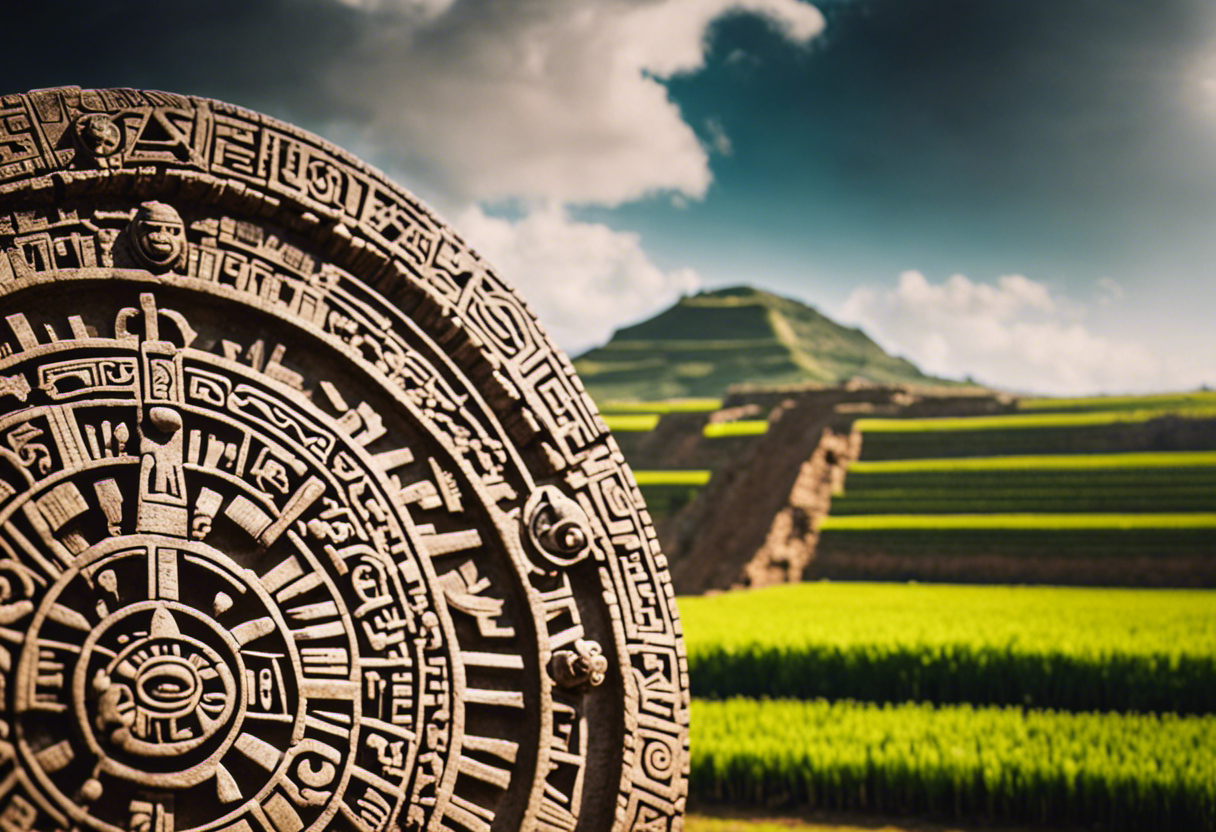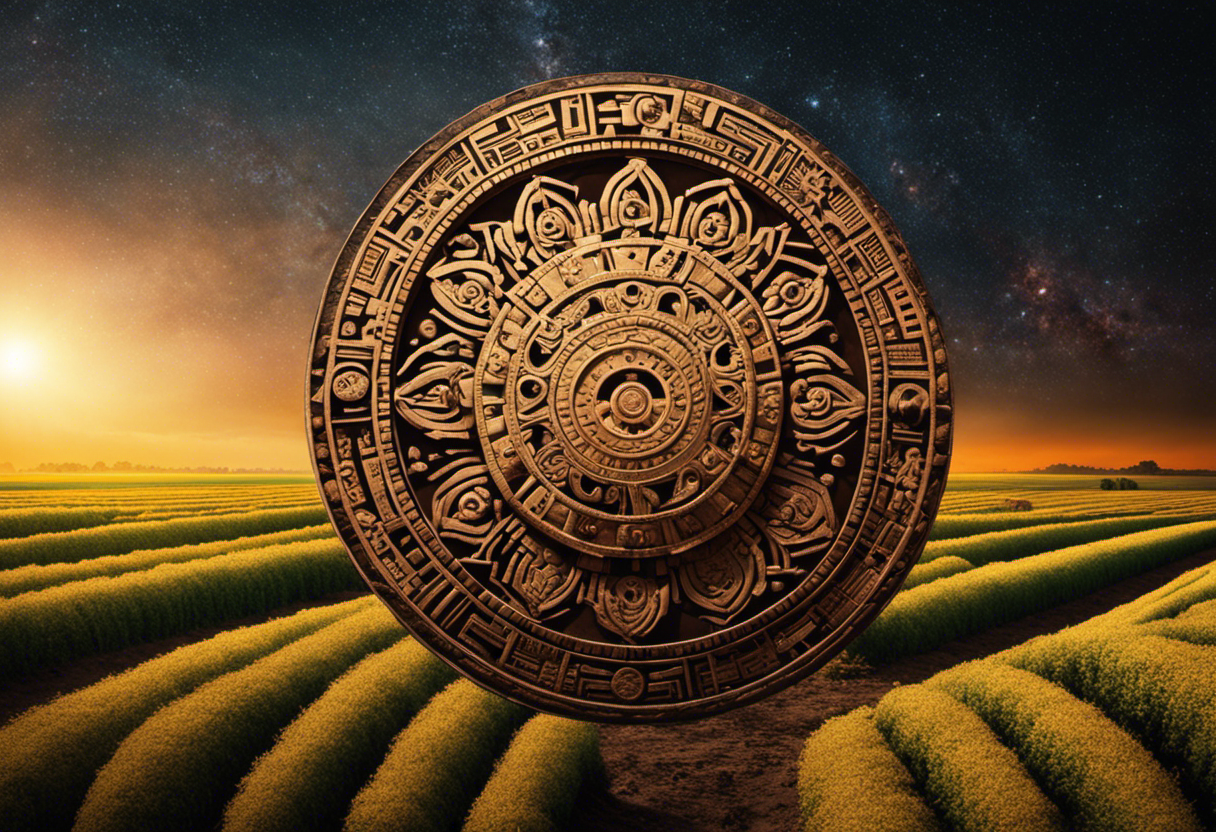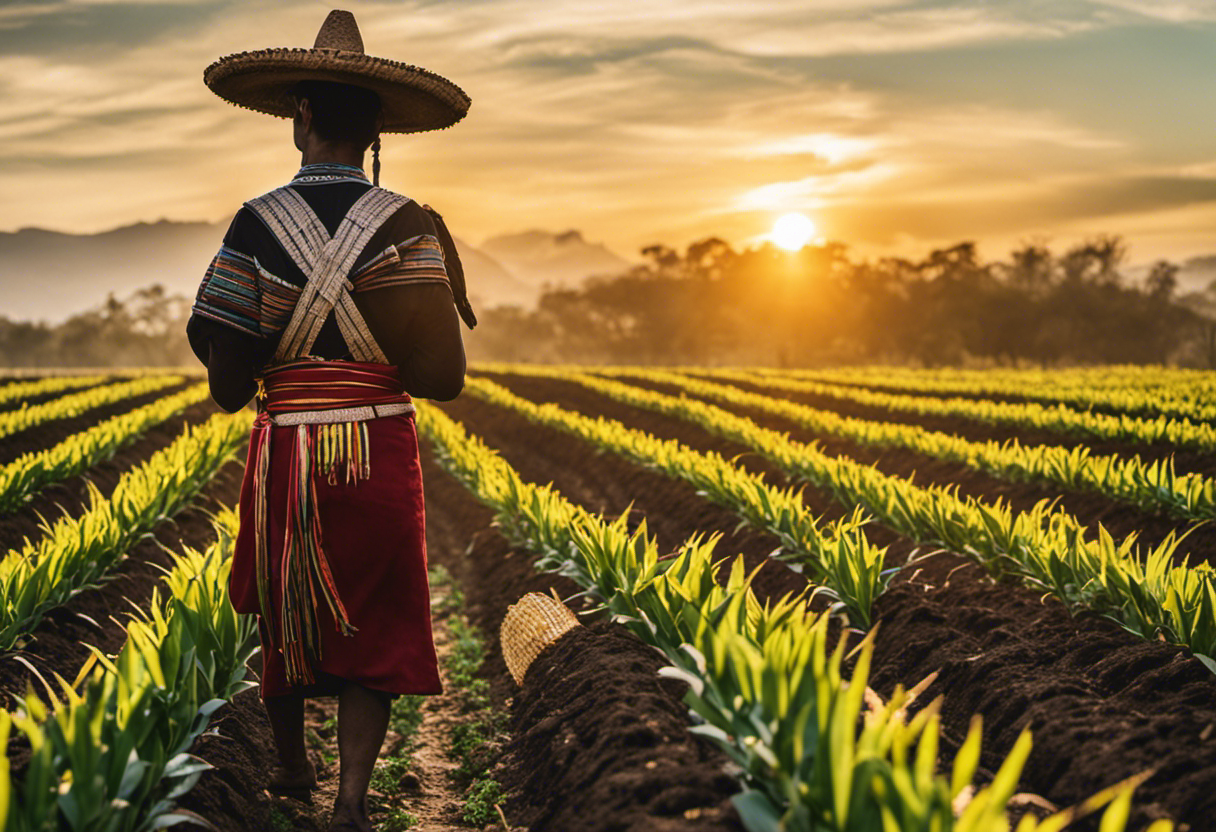Step back in time and delve into the fascinating world of the Aztec civilization, where the celestial and agricultural realms intertwined in a remarkable dance of symbiosis.
In this article, we explore the profound impact of the Aztec Calendar on agriculture, uncovering the intricate connections between the cosmic forces and the cultivation of crops.
From planting rituals aligned with the celestial movements to the legacy that echoes through modern agricultural practices, join us as we sow the seeds of time and unravel the hidden secrets of the Aztec Calendar’s role in shaping the bountiful harvests of the past.
Key Takeaways
- The Aztec calendar was not just a tool for measuring time but also a predictor of agricultural events.
- By observing the positions of stars, moon, and sun, the Aztecs could predict the best times for planting and harvesting.
- The calendar guided the timing of construction and maintenance of chinampas for crop cultivation.
- Agricultural rituals and festivals played a significant role in ensuring bountiful harvests.
The Aztec Calendar: A Cosmic Guide to Agriculture


The Aztec calendar plays a pivotal role as an indispensable cosmic guide to the intricate workings of agriculture. The calendar was not just a tool for measuring time but also a predictor of agricultural events. It allowed the Aztec people to align their farming practices with the celestial connections and natural rhythms of the universe.
The Aztecs believed that the movements of the celestial bodies influenced the growth and development of crops. By observing the positions of the stars, moon, and sun, they were able to predict the best times for planting, harvesting, and performing other agricultural activities. The calendar provided them with the knowledge and guidance needed to optimize their agricultural practices.
One of the key aspects of the Aztec calendar was its focus on cycles and patterns. The calendar consisted of several interlocking cycles that repeated over time. These cycles were believed to correspond to the cycles of nature, such as the changing of the seasons and the ebb and flow of the rivers. By following the calendar, the Aztec people were able to synchronize their agricultural activities with these natural cycles, ensuring a bountiful harvest.
The Agricultural Significance of the Aztec Calendar


Frequently overlooked, yet undeniably crucial, the Aztec calendar held immense agricultural significance in guiding the farming practices of the Aztec civilization. The Aztecs recognized the connection between the calendar and weather patterns, using it to inform their farming techniques. The calendar consisted of two systems, one based on the solar year and the other on the sacred 260-day ritual cycle. By observing the movements of celestial bodies, the Aztecs were able to predict the changing seasons and determine the most favorable times for sowing and harvesting crops.
The Aztec calendar’s connection to weather patterns enabled farmers to align their agricultural activities with the natural rhythms of the earth. For example, they could anticipate the arrival of the rainy season, known as the ‘wet years,’ and plan their planting accordingly. They also understood the importance of balancing water resources, as excessive rainfall could lead to flooding and crop damage. By carefully timing their planting and irrigation practices, the Aztecs maximized their agricultural output.
Furthermore, the farming techniques of the Aztecs were heavily influenced by the calendar. They practiced a form of agriculture known as chinampas, which involved the creation of artificial islands in lakes and swamps for cultivating crops. The calendar guided the timing of the construction and maintenance of these chinampas, ensuring optimal conditions for crop growth.
Planting and Harvesting Seasons in Aztec Agriculture


The planting and harvesting seasons in Aztec agriculture were crucial for the success of their crop yields. The Aztecs relied on a deep understanding of the seasons and the natural environment to determine the optimal times for planting different crops.
This knowledge was passed down through generations and was intertwined with their agricultural rituals and festivals, which played a significant role in ensuring bountiful harvests.
Seasonal Crop Yields
Optimizing crop yield in Aztec agriculture required careful planning and coordination of planting and harvesting seasons. The Aztecs utilized various techniques to ensure a successful harvest and maximize their agricultural productivity. Here are four key factors that contributed to their seasonal crop yields:
- Crop rotation: The Aztecs practiced crop rotation to maintain soil fertility and prevent the depletion of nutrients. By rotating their crops, they could effectively manage pests and diseases while replenishing the soil with essential nutrients.
- Irrigation techniques: The Aztecs were skilled in utilizing irrigation systems to provide water to their crops. They constructed canals, ditches, and terraces to distribute water efficiently, ensuring that their crops received the necessary moisture for growth and development.
- Observation of celestial events: The Aztecs closely observed celestial events, such as the movements of stars and the position of the sun, to determine the optimal time for planting and harvesting. They believed that aligning their agricultural activities with these celestial events would lead to bountiful harvests.
- Knowledge of local climate: The Aztecs had an intimate understanding of their local climate and its impact on crop growth. They adapted their planting and harvesting seasons according to the specific climatic conditions of their region, further optimizing their crop yields.
Through the implementation of crop rotation, irrigation techniques, celestial observation, and climate knowledge, the Aztecs were able to achieve high seasonal crop yields and sustain their civilization.
Agricultural Rituals and Festivals
Agricultural rituals and festivals played a significant role in the planting and harvesting seasons of Aztec agriculture. The Aztecs had a deep connection with the land and believed that performing specific rituals would ensure a successful harvest. These agricultural celebrations were based on their religious beliefs and were conducted according to their traditional farming methods.
During the planting season, the Aztecs celebrated the festival of Tlacaxipehualiztli, which marked the beginning of the agricultural cycle. This festival involved the sacrifice of a young warrior who would be skinned and his skin worn by a priest, symbolizing the renewal of life and fertility.
Similarly, during the harvest season, the Aztecs celebrated the festival of Hueytozoztli. This festival was dedicated to the god of rain, Tlaloc, and was a time of gratitude and offering for a bountiful harvest. The Aztecs would bring the first fruits of their harvest and offer them to the gods.
These agricultural rituals and festivals not only played a crucial role in the Aztec religious practices but also served as a means to ensure the success of their crops and the prosperity of their community.
Rituals and Festivals Aligned With the Aztec Calendar


Rituals and festivals played a significant role in the cultural and social fabric of the Aztec civilization, with their alignment to the Aztec calendar shaping the communal experience and spiritual beliefs.
The Aztecs had a deep reverence for their calendar, which they believed was a sacred tool that connected them to the divine realm.
Here are some of the key rituals and festivals that were aligned with the Aztec calendar:
- New Fire Ceremony (Xiuhmolpilli): This festival marked the end of a 52-year cycle in the Aztec calendar. It involved extinguishing all fires and then relighting them from a sacred fire. This ritual was believed to restore cosmic order and renew the energy of the universe.
- Feast of the Sun (Huey Tecuilhuitl): Held every four years, this festival honored the sun god, Huitzilopochtli. It included elaborate processions, music, dancing, and offerings of food and precious objects.
- Day of the Dead (Mictecacihuatl): This ritual was dedicated to honoring the deceased and celebrating their journey to the afterlife. Families would create altars adorned with flowers, food, and personal items to welcome the spirits of their loved ones.
- Tlacaxipehualiztli: This festival celebrated the god Xipe Totec and involved human sacrifices. Participants would wear the flayed skin of sacrificial victims as a symbol of rebirth and renewal.
These rituals and festivals were not only religious in nature but also served as opportunities for social bonding and community cohesion. They reflected the Aztecs’ deeply ingrained belief in the cyclical nature of time and the interconnectedness of the spiritual and earthly realms.
The Role of the Aztec Calendar in Crop Selection


The Aztec calendar played a significant role in guiding crop selection and agricultural practices.
The correlation between the calendar and crops allowed the Aztecs to align their farming activities with the seasons, ensuring optimal conditions for planting, harvesting, and storing food.
This evidence-based approach to crop selection contributed to the success and sustainability of their agricultural system.
Calendar and Crop Correlation
While the Aztec calendar played a central role in the selection of crops, it also served as a guide for determining the most auspicious times for planting and harvesting. The correlation between the Aztec calendar and crop cultivation was based on the understanding of the climate patterns and traditional farming methods.
Here are four key points to consider:
- Seasonal Variations: The Aztec calendar helped farmers identify the different seasons and their associated climate patterns. This knowledge was crucial in determining the appropriate crops to plant during each season.
- Rainfall Patterns: The Aztec calendar also provided insights into the rainfall patterns, allowing farmers to plan their planting and harvesting activities accordingly. They knew which crops would thrive in the wet or dry seasons.
- Crop Rotation: The Aztec calendar guided farmers in implementing crop rotation, a practice that helped maintain soil fertility and prevent the depletion of nutrients. This ensured sustainable agriculture and higher crop yields.
- Rituals and Offerings: The Aztec calendar also influenced the timing of rituals and offerings related to agriculture. Farmers believed that by performing these ceremonies at the right time, they could ensure a bountiful harvest.
Seasonal Farming Practices
Moreover, the Aztec calendar played a vital role in determining the appropriate crops to cultivate during different seasons.
The Aztecs were skilled farmers who understood the importance of crop rotation and irrigation techniques in maintaining soil fertility and maximizing agricultural output.
Their calendar system helped them plan their farming activities according to the seasons, ensuring that they cultivated the right crops at the right time.
By following a systematic crop rotation schedule, the Aztecs were able to replenish the soil with essential nutrients and prevent the depletion of resources.
Additionally, the Aztecs utilized advanced irrigation techniques, such as chinampas, to provide water to their crops even during dry seasons.
These practices allowed them to sustain a thriving agricultural system and support their growing population.
The Legacy of the Aztec Calendar on Modern Agriculture


Through the centuries, the influence of the Aztec calendar on modern agriculture has remained steadfast. This ancient calendar system not only provided a means to track time but also played a significant role in shaping farming practices and promoting sustainable techniques. The legacy of the Aztec calendar on modern agriculture can be seen in the following ways:
- Crop Diversity: The Aztec calendar, with its intricate understanding of seasonal cycles, allowed farmers to plan their agricultural activities accordingly. By aligning planting and harvesting times with the calendar, Aztec farmers were able to cultivate a wide variety of crops throughout the year. This practice of diversifying crops not only increased food security but also contributed to the preservation of biodiversity.
- Sustainable Farming Techniques: The Aztec calendar emphasized the importance of living in harmony with nature. The agricultural practices derived from this calendar system promoted sustainable farming techniques such as crop rotation, terracing, and agroforestry. These techniques helped to maintain soil fertility, prevent erosion, and conserve water resources, ensuring the long-term sustainability of agricultural production.
- Cultural Preservation: The Aztec calendar also played a crucial role in preserving cultural knowledge and traditions related to agriculture. It served as a repository of agricultural wisdom, passing down knowledge from generation to generation. Today, the Aztec calendar continues to inspire indigenous communities and farmers to maintain their cultural heritage and continue practicing sustainable farming methods.
- Adaptation to Climate Change: The Aztec calendar’s understanding of seasonal patterns and weather fluctuations allowed farmers to adapt their agricultural practices to changing climatic conditions. This adaptability is particularly relevant in the face of climate change, as it enables farmers to make informed decisions about crop selection, irrigation, and pest management.
Conclusion
In conclusion, the Aztec calendar served as a cosmic guide to agriculture, influencing planting and harvesting seasons, as well as crop selection.
Rituals and festivals were aligned with the calendar, further highlighting its significance in agricultural practices.
Today, the legacy of the Aztec calendar can still be seen in modern agriculture, as it continues to shape our understanding of time and its relationship to the cultivation of crops.
The Aztecs’ profound understanding of the celestial rhythms has left an indelible mark on the world of agriculture.




